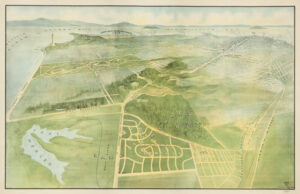Adolph Sutro: The Father of Tree Planting in California
My appreciation of the unique forest Adolph Sutro created near my San Francisco home on Mt. Davidson (below) over a century ago, has peaked my curiosity into why he planted it. It lead to my seeking his personal papers and researching other sources. Except for his papers, almost every other source referenced the Adolph Sutro: A Biography by Robert E. Stewart, Jr. and Mary Francis Stewart. Not wanting to leave any stone unturned, I recently read their 243-page out-of-print book published in 1962.
The most comprehensive researchers of Adolph Sutro to date, note that his interest in nature started with his childhood in Aachen Germany, “He spent much time in the forests near his natal city and was often accompanied by a botany teacher on his walks. The teacher used to say, ‘My son, live ever near to Nature’s heart, for to depart from Nature is to depart from happiness. choose companions among such as love trees and little children. the man who loves these can never commit a crime.’ ”
Once he came to America and began building his famous four-mile long tunnel into the silver-laden Comstock Lode in Nevada , he decided to create the model town of Sutro at the entrance in 1872. It included plans (below) for broad sidewalks, two tree-lined boulevards, and four parks. According to the Stewarts:
“Sutro started developing an interest in trees which would stay with him all the rest of his life. He owned a few trees before, but now saw in them a way to benefit mankind. He would have trees planted along Florence and Tunnel Avenues at company expense and the sale of the lots would be contingent upon the purchaser’s planting and caring for a tree in front of his house. Trees were good for people. They improved the appearance of a town, they furnished shade and brought other benefits, so trees the people must have. … each eleven-acre park was planted with trees and alfalfa. There were 2,000 Lombardy poplars in North Square and cottonwoods in South Square. On the Moore ranch a tree nursery had been established and 1,000 honey locust, 500 spruce, 1,000 elms, 500 sugar maples and 4,000 Lombardy poplars were being cared for.”
After finishing the tunnel project and selling his stock in it, he purchased the Sutro Heights property overlooking the Pacific Ocean for his home in San Francisco in 1881. The Stewarts astutely observed:
“If Sutro had elected to tear down the Tetlow cottage and erect a massive monument in its place he would have been behaving in a manner typical of many of his contemporary millionaires. As real estate prices rose he could have had his share of ghastly turrets, solid gold bathrooms, or vaulted ceilings. Nob Hill was studded with enormous homes, many of which owed their existence to Comstock fortunes. … What another man might have spent on a dwelling, he spent on the gardens around his home. While Flood, Fair, Crocker, and even Mark Hopkins built costly homes, Sutro made do with the old Tetlow cottage … With the forester growing trees by the thousands, Sutro also began considering ways of getting them planted and growing all over the city.”
As many other sources have noted, the Stewarts confirm the pivotal event where Sutro was honored as the Father of Tree Planting in California:
“One person to whom Sutro talked about trees was Joaquin Miller, the poet. … Together they planned California’s first Arbor Day, November 27, 1886, and with a large group of state officials they went by government boat to barren Yerba Buena Island and planted 30,000 trees. Simultaneously the school children of San Francisco were holding similar exercises and planting trees given by Sutro at the Presidio and at Ft. Mason. Eventually Mt. Parnassus (now known as Mt. Sutro) was planted. Sutro continued to provide trees for the children each year, and is estimated to have given away millions of seedlings of cypress and of Pinus maritama which he imported from the coast of the Black Sea.” By the time of his death, Sutro’s Forest extended four miles from Mt. Sutro south to Ocean Avenue.
Instead of using his Comstock Lode fortune to enrich himself, the Stewarts’s research revealed that Adolph Sutro spent his “large sums of money for his favorite objects — trees, shrubs, and books,” to enrich the lives of his fellow San Franciscans, leaving us a beautiful forested landscape and the finest private library in America!
Posted January 31, 2015




